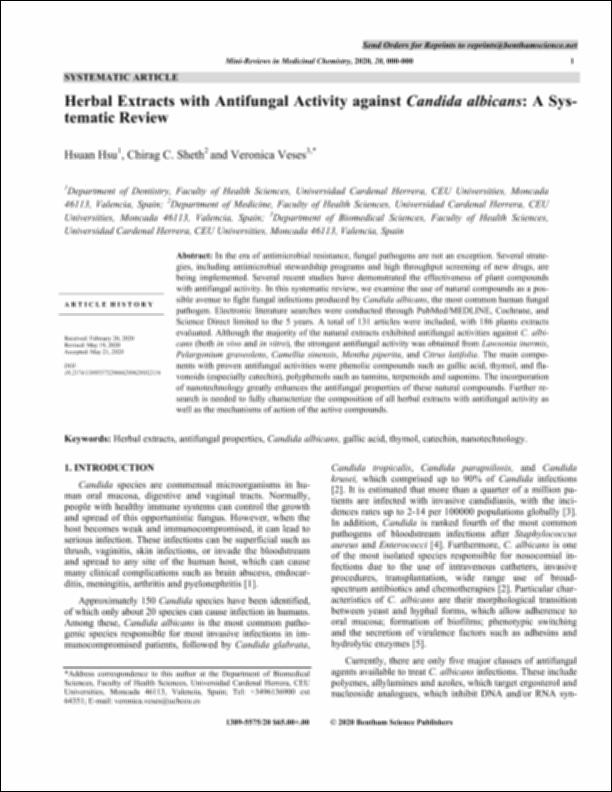Please use this identifier to cite or link to this item:
http://hdl.handle.net/10637/11721Herbal extracts with antifungal activity against "Candida albicans" : a systematic review
| Title: | Herbal extracts with antifungal activity against "Candida albicans" : a systematic review |
| Authors : | Hsu, Hsuan Sheth Shah, Chirag Chandrakant Veses Jiménez, Verónica. |
| Keywords: | Fitoterapia.; Herbal medicine.; Fungicidas.; Candida Albicans - Treatment.; Hongos patógenos - Tratamiento.; Pathogenic fungi - Treatment.; Cándida albicans - Tratamiento.; Fungicides. |
| Publisher: | Bentham Science Publishers. |
| Citation: | Hsu, H., Sheth, CC. & Veses, V. (2021). Herbal extracts with antifungal activity against "Candida albicans": a systematic review. Mini-Reviews in Medicinal Chemistry, vol. 21, i. 1, pp. 90 - 117. DOI: https://doi.org/10.2174/1389557520666200628032116 |
| Abstract: | In the era of antimicrobial resistance, fungal pathogens are not an exception. Several strategies, including antimicrobial stewardship programs and high throughput screening of new drugs, are being implemented. Several recent studies have demonstrated the effectiveness of plant compounds with antifungal activity. In this systematic review, we examine the use of natural compounds as a possible avenue to fight fungal infections produced by Candida albicans, the most common human fungal pathogen. Electronic literature searches were conducted through PubMed/MEDLINE, Cochrane, and Science Direct limited to the 5 years. A total of 131 articles were included, with 186 plants extracts evaluated. Although the majority of the natural extracts exhibited antifungal activities against C. albicans (both in vivo and in vitro), the strongest antifungal activity was obtained from Lawsonia inermis, Pelargonium graveolens, Camellia sinensis, Mentha piperita, and Citrus latifolia. The main components with proven antifungal activities were phenolic compounds such as gallic acid, thymol, and flavonoids (especially catechin), polyphenols such as tannins, terpenoids and saponins. The incorporation of nanotechnology greatly enhances the antifungal properties of these natural compounds. Further research is needed to fully characterize the composition of all herbal extracts with antifungal activity as well as the mechanisms of action of the active compounds. |
| Description: | Este artículo se encuentra disponible en la página web de la revista en la siguiente URL: https://www.eurekaselect.com/183227/article This is the peer reviewed version of the following article: Hsu, Hsuan, Sheth, Chirag C. & Veses, Veronica (2020). Herbal extracts with antifungal activity against "Candida albicans": a systematic review. Mini-Reviews in Medicinal Chemistry, vol. 20, which has been published in final form at https://doi.org/10.2174/1389557520666200628032116. Este es el postprint del siguiente artículo: Hsu, Hsuan, Sheth, Chirag C. & Veses, Veronica (2020). Herbal extracts with antifungal activity against "Candida albicans": a systematic review. Mini-Reviews in Medicinal Chemistry, vol. 20, que se ha publicado de forma definitiva en https://doi.org/10.2174/1389557520666200628032116. |
| URI: | http://hdl.handle.net/10637/11721 |
| Rights : | http://creativecommons.org/licenses/by-nc-nd/4.0/deed.es |
| ISSN: | 1389-5575 1875-5607 (Electrónico) |
| Issue Date: | 4-Jan-2021 |
| Center : | Universidad Cardenal Herrera-CEU |
| Appears in Collections: | Dpto. Ciencias Biomédicas |
Items in DSpace are protected by copyright, with all rights reserved, unless otherwise indicated.


